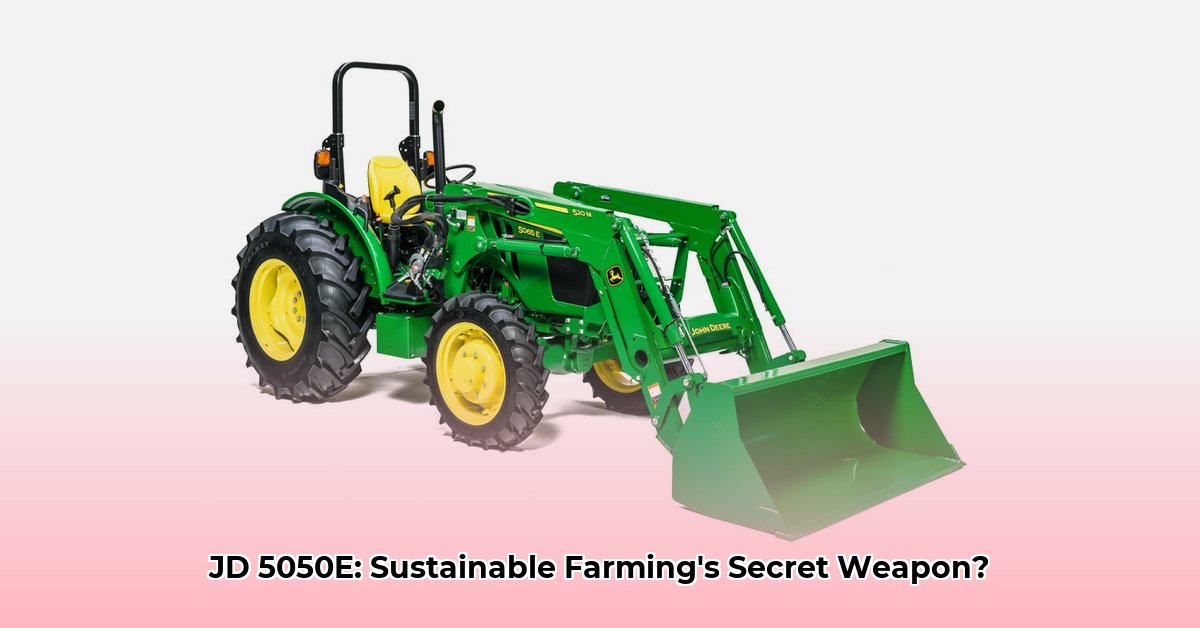
The John Deere 5050E, a 50-horsepower utility tractor, presents a compelling case for farmers seeking a balance between affordability and sustainable practices. While lacking overtly "green" features like hybrid technology, its design and performance contribute indirectly to environmental responsibility. This review analyzes its performance, ergonomics, sustainability aspects, market position, and offers actionable recommendations. For more information on John Deere tractors, see the John Deere Tractor Specs.
Performance & Efficiency: A Workhorse with Potential
The 5050E is powered by a John Deere PowerTech™ 3029 EWR engine, designed for efficiency and to meet emission standards. This engine requires less maintenance compared to some competitors, translating to reduced downtime and potentially lower operational costs. While precise fuel consumption data isn't readily available for this review, the engine's design suggests improved fuel efficiency compared to older models. Reduced maintenance further contributes to lower overall running costs, a key factor in sustainable farming. However, a comprehensive comparison against rival tractors from brands like Kubota or Mahindra is needed for a definitive judgment on its performance and costs. This comparison would assess operational costs, servicing requirements, and long-term durability.
Ergonomics & Operator Experience: Comfort Leads to Efficiency
Long hours in the field demand an ergonomic machine. The 5050E addresses this with improvements to hand throttle placement and redesigned loader controls, aimed at minimizing operator fatigue. Reduced fatigue translates directly to increased efficiency and reduced errors—minimizing wasted resources and maximizing output. A comfortable operator is a productive operator, directly benefiting sustainable farming through improved yields and resource management. Further research into quantifying the impact of improved ergonomics on operator productivity would be beneficial.
Sustainability Aspects: Indirect Contributions to a Greener Future
The 5050E does not boast hybrid technology or advanced precision farming integrations found in some higher-end models. However, its contributions to sustainable agriculture are indirect. Improved fuel efficiency (although specifics are currently unavailable), reduced maintenance requirements, and lower emissions directly address environmental concerns. The absence of a comprehensive Life Cycle Assessment (LCA) is a notable limitation preventing a complete evaluation of its environmental impact. However, this is a point of improvement that John Deere and similar manufacturers should address to provide fully transparent environmental assessments. John Deere's broader sustainability initiatives should also be considered when evaluating this tractor's overall environmental impact.
Market Context & Competition: Finding the Right Fit
The 5050E's position within the 50-horsepower utility tractor market necessitates a thorough comparison with competitors like Kubota and Mahindra. A detailed analysis of pricing, features (including available implements and options), and long-term cost of ownership is crucial for farmers evaluating this tractor. This comparison should assess not only fuel-efficiency but also maintenance costs, parts availability, and resale value to determine its overall value proposition. Further research to gather this data would greatly enhance this analysis.
Conclusion & Recommendations: A Solid Foundation, Room for Improvement
The John Deere 5050E represents a practical choice for farmers prioritizing efficiency and seeking to minimize their environmental impact. While lacking cutting-edge sustainable features, its robust engine, improved ergonomics, and reduced maintenance contribute to a sustainable farming approach. However, a detailed comparison with competitive models, along with the publication of a comprehensive Life Cycle Assessment by John Deere, would provide a more complete picture.
Actionable Recommendations:
- Farmers: Conduct a thorough cost-benefit analysis encompassing fuel consumption, maintenance, and potential improvements in operator productivity. Direct comparisons with similar tractors are crucial.
- John Deere: Commission and publish a complete LCA of the 5050E, transparently disclosing its environmental impact from cradle to grave. Prioritize the development of more explicitly sustainable features in future models, such as integration with precision farming technologies.
- Agricultural Researchers: Conduct comparative studies on the fuel efficiency and operational costs of different 50-horsepower utility tractors, including the 5050E. Research is needed to quantify the economic benefits from the 5050E's improvements in operator comfort and reduced fatigue.
The 5050E is a solid workhorse, but further improvements in sustainable features and transparent data are needed to fully realize its potential in a rapidly evolving agricultural landscape.